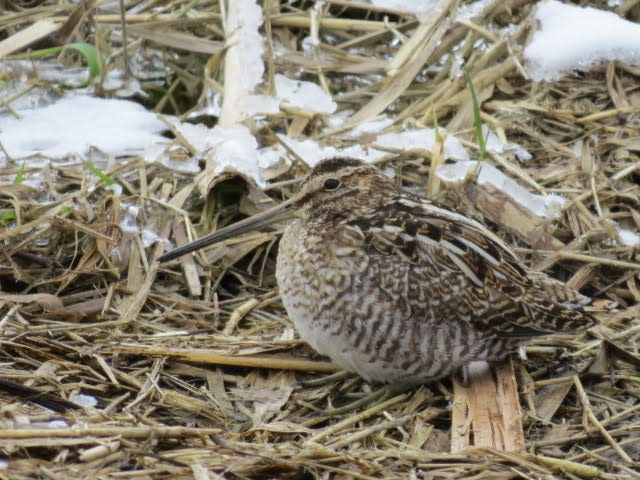Wayne County is for the birds, literally

Did you know Wayne County is home to several Important Bird Areas? The designation of Important Bird Area (IBA) is granted through the National Audubon Society as part of a global initiative started by the organization BirdLife International.
According to the Audubon Society, an IBA is an area that is identified, using a set of scientific criteria that assesses health and significance of bird habitat, as being globally important for the conservation of bird populations.
Growing food: Do you know where your food is grown?
Locally, author John Ritzenthaler says, "The IBA program serves as a catalyst for local, community-based action to ensure the long-term stewardship and conservation of the states diverse natural resources.” If you want to read more about IBAs, visit Audubon.org, or find the book “Important Bird Areas of Ohio” by Rtizenthaler and Audubon Ohio.
In Wayne County, we have ties to three IBAs. Those areas are Funk Bottoms, Killbuck Valley and the Wayne/Holmes region. As you explore just outside the borders of Wayne County, other IBAs like The Wilderness Center in Wilmot, Mohican State Forest in Loudonville and Pleasant Hill Lake in Perrysville also provide critical habitat for an extensive amount of bird species. The Wilderness Center in fact, is designated as a Global IBA.
New candy shop in Millersburg: New location in downtown a big hit for Troyer's Sweet Shoppe
Funk Bottoms top area for Sandhill Crane breeding
The three IBAs in Wayne County are all incredibly diverse and all feature different habitat and the opportunity to view a wide variety of bird species. Funk Bottoms, which consists of over 2,000 acres of wetlands and floodplain, is the top area in the state for Sandhill Crane breeding populations.
The area also is prime habitat for shorebirds and a hotspot during waterfowl migration. Funk Bottoms has produced excellent opportunities to view various sparrow species and somewhat consistently hosts Short-eared owls in the winter.
The Killbuck Valley IBA actually is two sub-areas that follow the Killbuck Creek. The northern half being what many know as Overton Valley, extending from just west of Wooster, north to the county line. The southern half technically begins around Prairie Lane Park, just south of Wooster and extends all the way into Holmes County, ending just north of Millersburg.
A large amount of this IBA consists of marshland and riparian zone. This IBA covers a majority of the largest wetland complex in Ohio south of Lake Erie. This area provides migration habitat to an enormous number of waterfowl every year. Like Funk Bottoms, it also provides ample resources for shorebirds during their migration.
The northern half provides opportunities to view Eagles, warblers, waterfowl, and many other woodland species, while the southern half, being comprised of significantly more marshland habitat, sustains birds like the Sandhill Cranes, Shorebirds and Rails, as well as the species that may be found in the northern area.
Barns, grassland, pastures prime for Barn Owls, Cliff Swallows
The intersect between Wayne and Holmes County, especially the eastern half, contains a large number of old barns and grassland or pastures. While this might not seem like anything unique, these two factors contribute significantly to viable habitat for Barn Owls and Cliff Swallows. Wayne and Holmes counties are actually top in the state for distribution and abundance of Barn Owls.
Outside of our IBAs, Wayne County is home to at least 60 birding hotspots, as designated by eBird.org. eBird is a citizen science website that helps to track bird species, both in numbers and geographic location. One look at the top hotspots for Wayne County, and you’ll realize how critically important the many different habitats that exist in Wayne County are for birds, be it for migration or for breeding grounds.
There are eBird hot spots all over the county: William J. Robertson Nature Preserve in Rittman, Wooster Memorial Park (west of Wooster), Kidron Park, Johnsons Woods State Nature Preserve, The College of Wooster, Secrest Arboretum and Barnes Nature Preserve, just to name a few.
Spring migration is ramping up
So, with spring migration just starting to ramp up, take this opportunity to get out in the county and explore our IBAs and bird hotspots. Ohio has over 60 State IBAs and 7 Global IBAs. There are hundreds of eBird hot spots around the state as well. This time of year is prime time to observe a wide array of warbler species, orioles, shorebirds, kinglets, vireos, thrushes and many others.
Northwest Ohio is known as the Warbler Capital of the World and hosts the Biggest Week in American Birding event that is centered around warbler migration. The area around Maumee Bay State Park and Magee Marsh is ground zero for this breathtaking display of warblers.
Needless to say, keep your eye on the sky while we are graced by our spring migrants. Look into eBird, and maybe even create an account to start your own birding “life list” and contribute to existing hotspots, or you may even have an opportunity to create a new one! There is still work to be done on IBAs, too. You can nominate additional sites to be IBAs.
Being outdoors can bring enjoyment and excitement for us all. There truly is something for everyone to find and appreciate in nature. Naturalist, author, and Ohio native Julie Zickefoose, who wrote “Saving Jemima: Life and Love with a Hard-Luck Jay”, expresses this sentiment for our feathered friends; “The presence of a single bird can change everything for one who appreciates them”.
Frank Becker is the Wayne County OSU Extension Agriculture & Natural Resources Integrated Pest Management Program Coordinator, and Certified Crop Adviser, and may be reached at 330-264-8722 or becker.5872osu.edu.
This article originally appeared on The Daily Record: Funk Bottom, Killbuck Valley, Pleasant Hill are big bird draw areas

